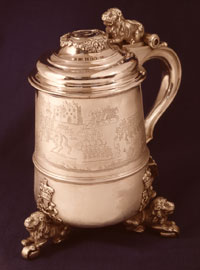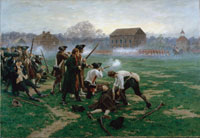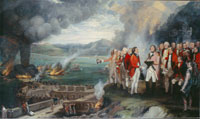

The Cumberland Tankard

NAM 1970-11-12
Defeat of the Highland Clans
This silver tankard commemorates the Duke of Cumberland’s victory over Charles Edward Stuart, ‘Bonnie Prince Charlie’, and the Jacobites at Culloden in Scotland on 16 April 1746. Cumberland’s victory ended the Jacobite Rebellion of 1745-1746 and safeguarded the Protestant succession. It also kept Britain free forever from an absolutist monarchy that rejected any notion that it’s authority was delegated by Parliament. Many people were shocked by Cumberland’s treatment of the enemy after the battle. Wounded Jacobites were bayoneted where they lay and Charles’s fleeing soldiers were ruthlessly hunted down. There then followed a period of severe repression in the Highlands. Cumberland’s men executed prisoners, burned settlements, seized livestock and dismantled the clan system, earning their commander the nickname ‘Butcher’. For Highland culture it was a disaster.
The Battle of Lexington, 1775

NAM 1959-11-302
Revolutionary spark
The Battle of Lexington on 19 April 1775, the famous ‘shot heard round the world,’ marked the start of the American War of Independence (1775-1783). While marching from Boston to seize military stores at Concord, Massachusetts, a British force encountered a group of ‘minute men’ (militia-men who had undertaken to turn out at a minute’s notice) gathered on the green at nearby Lexington. After a brief skirmish, with few casualties on either side, the Americans withdrew. The British then pressed on to Concord Bridge where a larger engagement was fought that led to a fighting retreat to Boston. Within two days, 15,000 men from across New England had assembled and surrounded the British troops in Boston. The war for independence, or American Revolution, had begun in earnest and the Continental Congress (a body representing the North American Colonies’ opposition to British policy) would soon adopt and sponsor these men into the beginnings of the Continental Army. The skirmishes at Lexington and Concord turned a colonial revolt against British economic policy into a fight for political independence and they have taken on an almost mythical quality in the American consciousness.
General Eliott and his officers observing the destruction of the floating batteries, during the Siege of Gibraltar, September 1782

NAM 1996-07-107
Resistance on the Rock
Britain first captured the territory of Gibraltar in 1704 during the War of the Spanish Succession (1702-1713). Despite attempts by Spain to recapture the town, it has remained British ever since. When Spain joined in the American War of Independence (1775-1783) in 1779, it set about besieging the British garrison on Gibraltar, commanded by General George Augustus Eliott (1717-1790). The siege reached a crisis point in September 1782, when the weakened garrison was bombarded by a number of specially designed floating batteries. In a daring and dangerous move, British gunners fired back with red-hot shot, setting the batteries on fire and causing some to explode. The Spanish fleet retreated and the garrison was able to keep up its resistance until the end of hostilities in 1783. For many years afterwards Gibraltar was an important base for the Royal Navy. Today, the issue of sovereignty over the rock remains a source of tension in Anglo-Spanish relations. All local political parties are opposed to any transfer of sovereignty to Spain, instead supporting self-determination for the rock.

